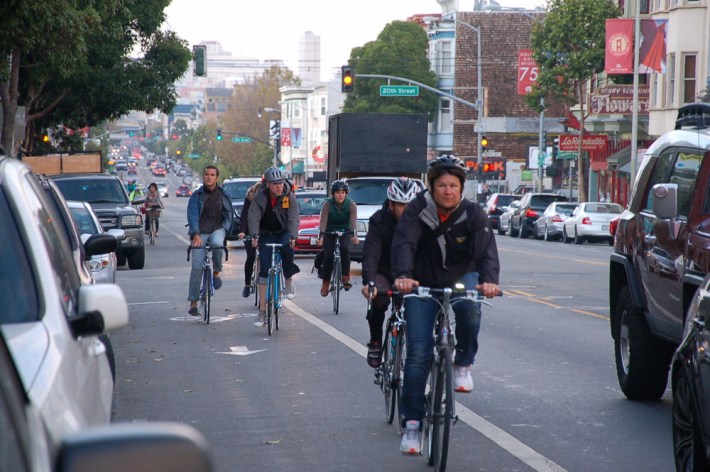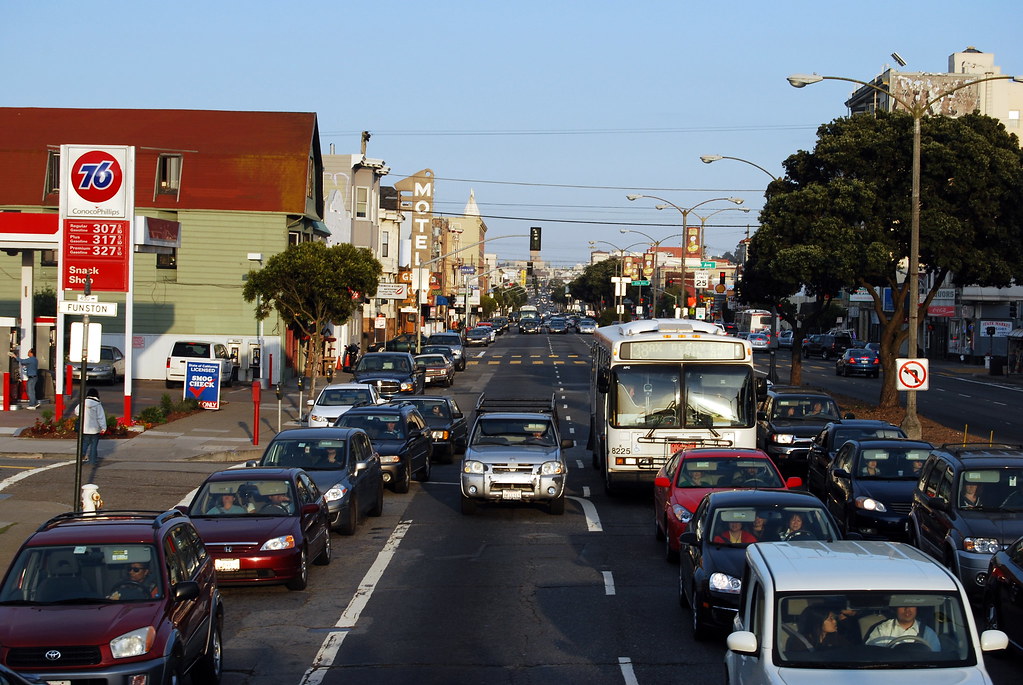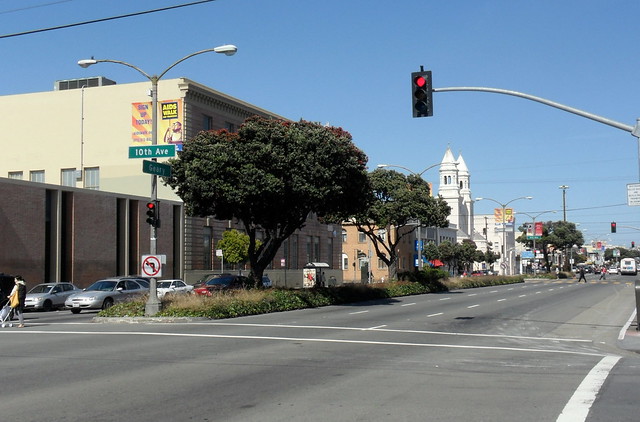At 40 Years, San Francisco’s Transit-First Policy Still Struggles for Traction
4:54 PM PDT on March 22, 2013
The first private automobile users on early 20th-century American streets were generally accorded no special privileges on the public right-of-way. "The center of the road was reserved for streetcars, and the new automobiles had to move out of the way," as Renee Montagne describes it in the 1996 documentary Taken for a Ride, which chronicles the decline of American public transit over the 20th century.
When the San Francisco Board of Supervisors adopted a transit-first policy on March 19, 1973 -- 40 years ago this week -- a return to the early 1900s streetscape may not have been what they had in mind, but the city's intent to undo decades of urban planning and governance geared towards promoting driving at the expense of public transit was clear. A key provision of the policy reads, "Decisions regarding the use of limited public street and sidewalk space shall encourage the use of public rights of way by pedestrians, bicyclists, and public transit, and shall strive to reduce traffic and improve public health and safety." (The policy was amended to include pedestrians and bicyclists in 1999.)
Yet today, the vast majority of San Francisco's street space remains devoted to moving and storing private automobiles, making the public right-of-way hostile to walking and bicycling. Muni remains underfunded, with vehicle breakdowns and delays caused by car traffic a daily part of riding transit.
"When there's excess road space that cars don't need, it's given over to bikes, peds, and transit," said Livable City Executive Director Tom Radulovich, "but where there's a real shortage of road space, in the most congested parts of the city, the car is still the priority."
"It seems like the transit-first policy is just a recommendation," said Jason Henderson, a geography professor at SF State University and author of the upcoming book Street Fight: The Politics of Mobility in San Francisco. "There's no requirement for the city's decision-makers to actually follow it."
Since Ed Reiskin became director of the SF Municipal Transportation Agency in July of 2011, he's helped develop a new strategic plan for the agency that sets a five-year goal of reducing driving to 50 percent of all trips, down from the current estimate of 62 percent -- a number that hasn't changed significantly since the 70s.
"We haven't really moved the needle that much," said Reiskin. "In the big scheme of things, a lot of people are still relying on their own single-occupant automobile to get around the city."
Even though action on the transit-first policy has been lacking in the decades since it was adopted, Reiskin commends the elected officials who enacted it for being ahead of their time. "Today, people are thinking much more about active transportation and being multi-modal, but 1973 was a different time, and the fact that the Board of Supervisors had that foresight was tremendous."
Still, the scant visible progress toward the transit-first vision over the last 40 years might lead anyone using San Francisco's streets to ask: What happened?
In the years immediately after the adoption of transit-first, advocates say the opening of BART and the Muni Metro system may have quelled the city's sense of urgency. The entire decade of the 1970s was marked by construction of the BART and Muni Metro tunnels under Market Street. The city did paint some downtown transit-only lanes soon after the policy adoption, but by the time the Muni Metro opened in 1980, other priorities may have put transit improvements on the backburner.
"We'd made some major leaps from where we were in the 60s, where we had ripped out the rail lines and basically forced everyone on to buses -- it was a really bad place," said Joél Ramos, a community planner for the sustainable transportation advocacy group TransForm and a member of the SFMTA Board of Directors. In the 1980s, Ramos surmises, "We were distracted trying to fight so many other battles, from a flailing economy, to fighting for more affordable housing, to dealing with environmental concerns."
Without any elected officials championing the implementation of the transit-first policy, Henderson says planners also found it difficult to overcome opposition to re-allocating road space from cars to transit, and the city failed to lay a foundation of stable funding sources for Muni improvements and operations. "Nobody owned it," said Henderson. "It's amounted to just maintaining the existing service, barely."
No doubt, San Francisco could have suffered a much worse, car-blighted fate. By the 70s, the city had already benefited from the Freeway Revolt of the previous decade, largely averting what befell other American cities, where highways tore apart the urban fabric. Even if the transit-first policy was "never fully implemented," a 1999 report from the SF Planning and Urban Research Association credits it for city planning decisions to accommodate massive downtown job growth with transit instead of driving, largely by restricting new parking:
Were it not for the transit-first policy, the city would have followed the path of so many other American cities, widening roads, narrowing sidewalks, demolishing downtown buildings and then filling the spaces with parking garages. We would have destroyed the very density and walkability that makes this city different from the rest of the country, that creates the high economic values of downtown, and that provides the quality of life we enjoy.
Peter Tannen first learned of the transit-first policy when he applied for a job as a San Francisco transportation planner in 1992 at what was then the Department of Parking and Traffic. "I was actually shocked on two counts," he said. "I thought, gee, I had no idea San Francisco had such a wonderful policy. And my other shock was looking around seeing that it wasn't being implemented very much."
When he started at DPT, Tannen said the agency had no staff dedicated to bicycle or pedestrian projects. He was the first manager of the department's Bicycle Program. When the SFMTA was created in 1999 (at the same time that voters approved the addition of priority for bicyclists and pedestrians into the transit-first policy), DPT was folded into it. Looking back from the vantage point of today's SFMTA, which has a Sustainable Streets division and a Livable Streets subdivision, Tannen, who retired in 2006, said he's witnessed an organizational, cultural, and political shift when it comes to putting safe walking and bicycling ahead of driving convenience.
Projects like one of the city's first road diets on Valencia Street -- a 1999 trial project that added bike lanes, leading to a 144 percent increase in bicycling on the street [PDF] in the first year -- or the removal of one parking space along the Wiggle, were a "really big deal," he said. "It happened, but now I see proposals to remove 30 or 40 parking spaces, and things actually happen."

But make no mistake: SFMTA efforts to reclaim parking and traffic lanes still often face strong resistance from residents with a car-first mentality. Just this week, angry residents fueled by a misinformation campaign rallied against SFMTA proposals at a neighborhood meeting, upset by the potential removal of parking spaces on Polk Street to make room for protected bike lanes and more public space.
"While I think most San Franciscans believe in the principles of the transit-first policy, when you start talk about changing traffic, parking, or transit, it very quickly becomes very personal for people," Reiskin told Streetsblog after the meeting. Still, he says, "We have a very clear policy mandate."
The SFMTA's Polk proposals would only remove, at the most, half of Polk's on-street parking, which altogether makes up just 7 percent of parking within a block's range of the business corridor, to create a safer street in an area where virtually every street is designed to be dominated by cars.
"You have a very continuous network for motorists in cars," notes Livable City's Radulovich. Meanwhile, "The pedestrian network, the transit-priority network, and the bicycle network, are still gappy, uneven, and completely missing from some parts of town."
While such fierce resistance might be on a downward trend, Morgan Fitzgibbons, who leads a sustainability-focused group called the Wigg Party, points the finger at the SFMTA and elected officials like Mayor Ed Lee for dragging their feet and placating car owners rather than firmly standing by the transit-first policy. Fitzgibbons wrote in an op-ed in the Huffington Post this week that while San Franciscans have waited for delayed projects like the Fell and Oak Street bikeways -- in which the SFMTA took time to create parking spaces on side streets to make up for parking loss -- officials in cities like New York and Chicago are setting concrete goals and moving ahead with bike lane implementation.
Dave Snyder, who previously served as head of the San Francisco Bicycle Coalition and transportation policy director for SPUR, pointed out that even today, the city is building a "ridiculous" amount of car parking in the redevelopment area of Mission Bay, which sits on flat bike-friendly terrain close to major regional transit lines and downtown.
"Transit-first needs to be owned by a politician," says Henderson. "A politician has to care for it in a way that they understand all the nuances, understand all the issues, and become a champion and spokesperson for it, because it's a political issue."
Henderson doesn't believe anyone has filled the role of transit-first champion, but Supervisor Scott Wiener has by far taken the most action on transportation reform at City Hall. Even if transit advocates don't always agree with his approach, Wiener has introduced legislation attempting to do everything from increase Muni funding to streamline pedestrian safety improvements to increase the availability of car-share.
If San Francisco were to be graded on its implementation of transit-first, "I would give us a C+," said Wiener. "In a lot of areas, the MTA is moving in the right direction, but it needs to move faster and more aggressively."
Wiener emphasizes that the transit-first policy is "not about making it hard to drive, but about giving people options other than driving their car."
"There are some people that are always going to drive their car, but there's a certain percentage of people who would get rid of their cars, or drive them a lot less, if they had other viable options," he said.
Ramos said "it's probably only in the last 10, 15 years that we've started to understand transit-first, and that it's not just something that we should be providing as part of our social fabric, but it should also be something that corresponds to improving the economy and a better, healthier environment. And I think it's going to take a while for that value to catch up with the mainstream."
"Most people are accustomed to a car-based lifestyle," he added, "and I think it's going to take some time to help people really understand that that's not really economically viable for the city. All of the subsidies that go into providing parking for cars, or the ramifications of not having safe places for people to ride bikes or even walk, are having an impact on the city as it continues to grow, and as cars become more ubiquitous on our streets."
Read More:
Stay in touch
Sign up for our free newsletter









